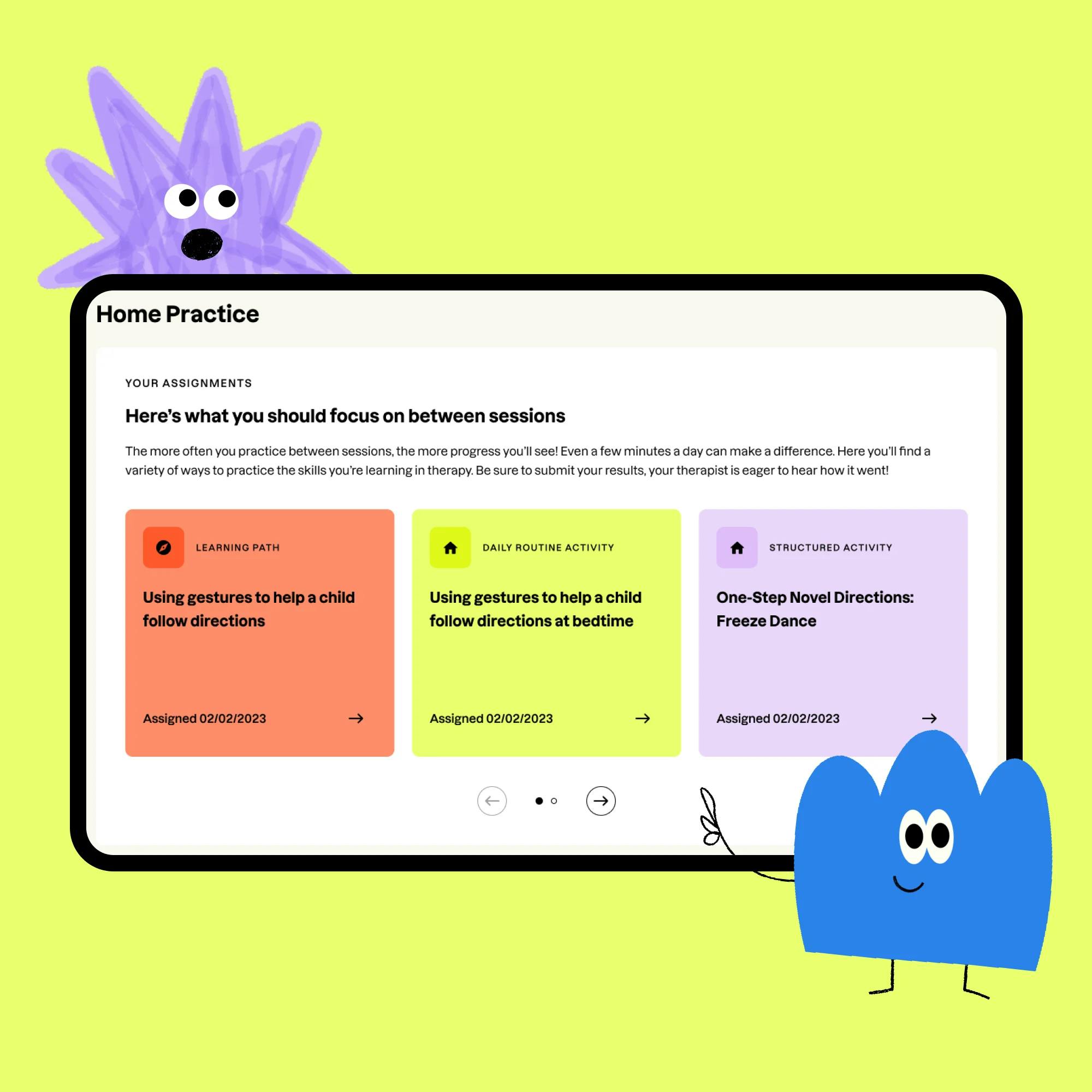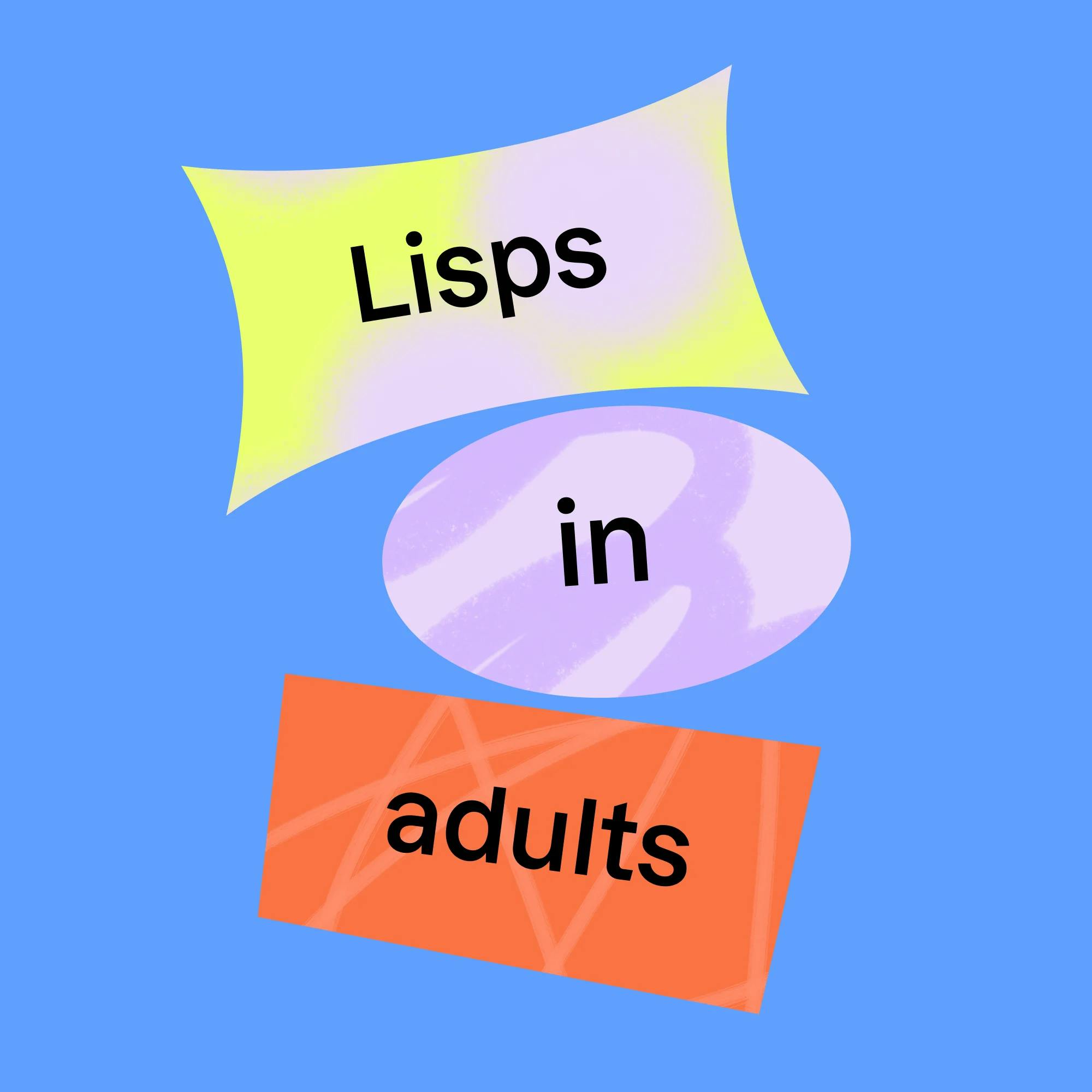Speech sound disorders, also called articulation disorders, can be common among young children as they are learning to talk. Some children may have difficulty pronouncing a few sounds, but eventually they catch up on their own.
When a child has a hard time saying sounds or words correctly past a certain age, this can be a sign of a speech sound disorder. As a caregiver, it can be stressful to watch your child struggle to speak clearly, especially when other people can’t understand them.
Adults, too, can struggle with speech sound disorders. Some adults have problems that started as a child and were never properly treated, so they've persisted over time. Other speech problems may have developed as a result of a stroke or traumatic brain injury. Speech sound disorders are a common condition treated at Expressable. We’ve put together this comprehensive guide to help you understand what causes speech articulation problems, the signs to look for, and how speech therapy can help you or your child speak more clearly.
Free speech skills screener
Questions are tailored by age and cover all areas of communication. Take our 5-minute online screener and get instant feedback.
 Start the screener
Start the screenerWhat is a speech sound disorder?
Children who can't pronounce certain sounds or words by an expected age may have a speech sound disorder. It's often difficult to understand someone with a speech sound disorder. In many cases, this speech problem can affect a person at school, at work, and socially. To produce speech sounds correctly, we need to (1) understand how to make the sound and (2) coordinate the movements needed to make the sound. This includes jaw, tongue, and lip movements along with breathing and vocalizing.
What are the types of speech sound disorders?
Generally speaking, there are two types of speech sound disorders: functional and organic. Understanding the type of speech sound disorder is key to effective treatment. This is why assessment and diagnosis by a licensed speech-language pathologist, also known as a speech therapist, is so important. Speech problems can be treated, and research has shown that earlier interventions lead to better outcomes.
Functional speech sound disorders
There are two types of functional speech sound disorders: articulation disorders and phonological disorders. The cause of a functional speech sound disorder is usually unknown.
Articulation disorders: To make a sound, we need to coordinate the movement of our lips, tongue, teeth, palate (top of the mouth), and respiratory system (lungs). Children with articulation disorders have difficulty using these motor functions to physically make the correct speech sounds. The result is the inability to form clear words. Sounds may be distorted, or they may be swapped for another sound. For example, saying the [th] sound for the /s/ sound, as in “thun” instead of “sun,” is an articulation disorder. In this case, the person can’t say the /s/ sound in any context or word.
Phonological disorders: Phonological disorders are characterized by a regular pattern of errors. The person may be able to make individual sounds correctly in some cases, but they have a hard time putting these sounds together to form words. For example, a person with a phonological disorder may be able to produce the /d/ sound on its own. But they may swap it out for the /g/ sound in certain words, saying “doe" instead of "go."


Organic speech sound disorders
In organic articulation disorders, the cause of the disorder is known:
Motor/neurological: Motor speech disorders occur when muscle coordination or strength is impacted. Motor speech disorders can be developmental or occur after neurological damage, such as a stroke or traumatic brain injury.
Structural: Differences in the structure of a person’s mouth or face can affect speech sound production. A cleft lip and palate is an example of this. Structural differences can also be caused by trauma or surgery.
Sensory/perceptual: Hearing impairment can cause speech sound difficulties. Children with hearing problems can’t hear speech sounds the way others produce them.
Expert speech support for adults
If you'd like to improve your speech skills, we're here for you. Get matched with a licensed speech therapist today.
 Get started
Get startedArticulation vs. phonological disorders: A closer look
Articulation and phonological disorders are very common for those in speech therapy, especially children. But telling the difference between articulation and phonological disorders isn't always easy. This is why a diagnosis by a speech therapist is so important. The type of speech sound disorder a person has will largely determine their treatment plan.
It can help to think of these two disorders like this:
An articulation disorder is a difficulty at a sound production and motoric level. People with this disorder have trouble physically making individual speech sounds.
A phonological disorder is a difficulty with understanding the meaning that sounds carry and the correct patterns to use the sounds in. Because of this, the person produces them incorrectly. They might be able to say sounds correctly when they repeat after someone, but they struggle to say the sounds correctly in words.
Compared to articulation disorders, it is often harder to understand someone with a phonological disorder. Many children with phonological disorders and phonemic awareness disorders (the understanding of sounds and sound rules in words) are likely to have problems with literacy. This can affect how well they do in school.


What are the signs and symptoms of a speech sound disorder?
While all children learn to talk on their own schedule, there are certain sounds they should be able to make by certain ages. According to the American Speech-Language-Hearing Association (ASHA), below are the ages when most English-speaking children should develop certain speech sounds.
Speech milestones for babies, toddlers, and preschoolers
By 3 months:
Makes cooing sounds
By 5 months:
Laughs and makes playful sounds
By 6 months:
Makes speech-like babbling sounds like puh, ba, mi, da
By 1 year:
Makes longer strings of sounds like mimi, upup, bababa
By 3 years:
Says /m/, /n/, /h/, /w/, /p/, /b/, /t/, /d/, /k/, /g/, and /f/ in words
People familiar with the child can understand their words
By 4 years:
Says /y/ and /v/ in words
May still make mistakes on /s/, /sh/, /ch/, /j/, /ng/, /th/, /z/, /l/, and /r/ sounds
Most people understand the child’s speech
If your child isn’t reaching some of these milestones, or their speech is hard to understand, they may have a speech articulation disorder. You can learn more about signs of a speech sound disorder in this article.

How common are speech articulation disorders?
According to the National Center for Health Statistics, speech problems are the most common type of communication disorder in children. Out of all children ages 3 to 17 years, 5% have a speech problem. Reports have estimated that speech sound disorders are more common in boys than in girls.
What causes a speech sound disorder?
Often, a speech sound disorder has no known cause. In other cases, several factors could be involved. Here are some possible factors that may cause or contribute to a speech sound disorder:
Brain damage, such as a head injury
Intellectual or developmental disability, such as autism
A genetic disorder, such as Down syndrome
Problems with hearing or hearing loss, such as a history of ear infections
Physical abnormalities that affect speech, including cleft palate or cleft lip
Disorders affecting the nerves involved in speech, such as cerebral palsy
Too much thumb sucking or pacifier use
According to ASHA, research has shown that the following risk factors may also increase a child’s likelihood of developing a speech sound disorder:
Gender: The incidence of speech sound disorders is higher in males than in females.
Pre- and perinatal problems: Factors such as maternal stress or infections during pregnancy, complications during birth, preterm delivery, and low birthweight were found to be associated with speech delay and speech sound disorders.
Family history: Children who have family members with speech and/or language difficulties may be more likely to have a speech disorder.


Apraxia of speech and dysarthria, which are motor speech disorders, can also cause speech problems:
Apraxia of speech: Childhood apraxia of speech and acquired apraxia of speech (more common in adults) are a neurological condition that affects how the brain sends messages to the muscles involved in speech production, such as the lips and tongue. A person with apraxia knows what they want to say, but the signals between the brain and the muscles are not sent correctly, so the person can't properly plan the required speech movements.
Dysarthria: Dysarthria is a motor speech disorder characterized as a weakness or inability to control the speech muscles. People with dysarthria may have a hoarse, soft, or even strained voice, or slurred or slow speech.


How are speech articulation disorders diagnosed?
It’s important to seek treatment for speech sound problems. With appropriate speech therapy, many children see major improvement in their ability to speak clearly and be understood by others. This helps them communicate their needs and feelings, form relationships, and stay safe. In addition, studies show that improving a child’s speech benefits their performance in school. For example, poor speech sound skills in kindergarten children have been linked with literacy problems. Research has also shown that preschool children with speech sound difficulties are more likely to have trouble reading as they get older.
Studies show that improving a child’s speech benefits their performance in school.
If your child’s speech is hard to understand, talk with your pediatrician. Most likely they will start by checking your child’s hearing. If hearing loss is ruled out, contact a licensed speech-language pathologist, also known as a speech therapist. They are the most qualified professionals to evaluate, diagnose, and treat speech sound disorders. The earlier speech therapy starts, the more quickly speech problems can be corrected. Your speech therapist will perform an evaluation to determine if your child's speech issues are a normal part of development or the result of a speech sound disorder. The speech therapist will use standardized or norm-referenced tests, such as the Goldman-Fristoe Test of Articulation, 3rd Edition (GFTA-3) and the Clinical Assessment of Articulation and Phonology, 2nd Edition (CAAP-2). They will assess your child's ability to be understood by listeners, as well as how they produce age-appropriate speech sounds in words and sentences. The speech therapist will ask you about your child’s medical history and observe how they move their lips, jaw, and tongue. The evaluation will provide a whole-picture view of what your child is doing well and what they may need support with.
Concerned about your child's speech?
We're here for you. Get matched with a speech therapist who's experienced in your child's area of need and available when you are.
 Find a speech therapist
Find a speech therapistHow are speech sound disorders treated?
Your speech therapist will partner with you to develop an individualized treatment plan to help your child’s speech become easier to understand. They’ll work with you and your child to:
Provide speech exercises so the condition doesn’t worsen
Identify sounds your child is pronouncing incorrectly
Teach your child how to correctly form certain sounds, using verbal, visual, and tactile cues
Practice and repeat sounds in different words and in longer sentences
Offer at-home strategies, activities, and games that you can use with your child to practice between sessions
You can learn all about Expressable’s approach to evaluating and treating articulation disorders in our treatment guide to speech sound disorders and our treatment guide to dysarthria.

Support beyond sessions: The Expressable portal
At Expressable, speech therapy doesn’t stop when the session ends. All Expressable clients have access to our client portal, which makes it easier to practice speech sound exercises at home. More practice leads to faster progress! Here’s what you’ll find in the portal:
Learning Paths that explain and reinforce therapy strategies, like speech modeling or using cues to practice certain sounds
Demo videos that show real techniques in action, such as how the mouth moves to make different sounds
Home practice activities you can do during everyday routines, like practicing speech sounds during meals, while in the car, or when a reading book
Text messaging support so you can ask questions and get tips from your therapist between sessions


How does online speech therapy work for articulation disorders?
Expressable matches families and adults with a licensed speech therapist trained to evaluate and treat speech delays and disorders. All therapy is delivered online via face-to-face video conferencing.
Your child’s age and development will influence how your speech therapist interacts with them through these video sessions.
Ages 0-3: Caregivers work directly with their child's speech therapist to learn cues and at-home strategies. This way they can confidently practice with their child outside the session and improve their child's speech.
Ages 3-6: Caregivers attend video sessions alongside their child so they both learn valuable skills from their speech therapist. Reinforcing these lessons outside the session will continue to promote at-home skill building.
Ages 7 and up: Most children attend video sessions independently, but caregivers are kept in the loop with updates and tips during each session.
Adults: Adults attend sessions by themselves but are welcome to bring loved ones to the sessions as well.


How can I help my child with speech problems at home?
It's hard to overstate the importance of your involvement in your child's speech therapy. Overcoming speech sound disorders takes time and persistence, and you can help your child practice at home every day, during your normal routines. Here are a few ways you can help your child learn to speak more clearly:
Listen carefully: Write down any sounds or words your child seems to be struggling with. Share these with your speech therapist so they can work on them during therapy sessions.
Make practice fun: Make sure your speech therapist recommends enjoyable games and activities you can do with your child at home.
Use flashcards or word lists: Make flashcards or lists of common household objects to help your child practice certain sounds. Practice these during games and fun activities, and praise your child for working hard!
Model correct sounds: If your child pronounces something incorrectly, give them an accurate model so they can hear the right sounds. You can do this by clearly restating what they said. For example, if they say “I’m pwaying wif da ball!,” you can respond “You’re playing with a red ball!”
It’s also easy and fun to practice speech sounds during storytime! Check out these book picks from our speech therapists that focus on a variety of sounds:
Find a speech therapist
If you’re concerned about your child’s speech development, or you want to improve your own speech, Expressable is here to help. We’ll match you with a licensed speech therapist who can perform an evaluation and guide you on the right next steps. Start our easy sign-up process here!
How Expressable Can Help
Concerned your child isn't reaching age-expected milestones? Looking for communication support from a professional? Expressable is a national online speech therapy practice serving children and adults. We treat all major areas of communication and feeding, offer flexible hours including evenings and weekends, and accept most major health insurance plans. We’re proud to have earned more than 3,000 5-star reviews from our clients (4.9/5 average).
Our therapy model is centered on parent and caregiver involvement. Research proves that empowering caregivers to participate in their loved one’s therapy leads to better outcomes. That’s why we combine live, 1-on-1 speech therapy with personalized education and home practice activities for faster progress.
Communication is more than words. It’s how we share how we feel and show who we are. We’re here to help you or your child do just that.

 Abby Barnes, M.S., CCC-SLP
Abby Barnes, M.S., CCC-SLP












